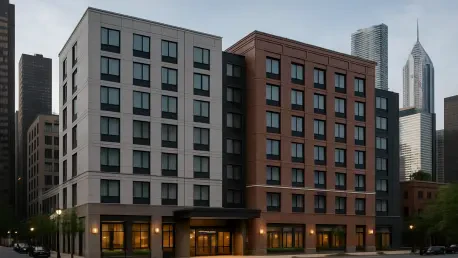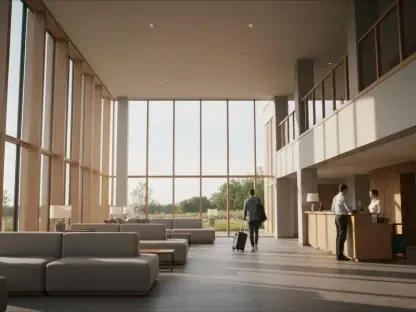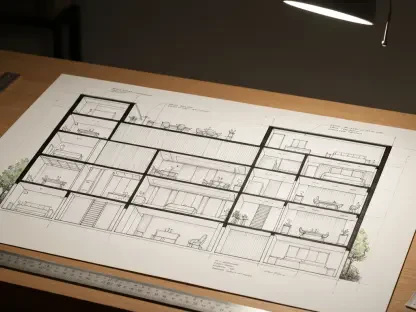Allow me to introduce Katarina Railko, a seasoned expert in hospitality management with a wealth of experience in the travel and tourism industry. Katarina has honed her skills across various sectors, including entertainment and events, where she’s become a prominent voice at expos and conferences. Today, we’re diving into her insights on managing dual-branded properties, preserving historic landmarks, and expanding in key markets like Chicago with First Hospitality’s latest venture, the Hyatt House and Hyatt Place Chicago – Medical/University District.
How did First Hospitality become involved in managing the Hyatt House and Hyatt Place Chicago – Medical/University District, and what does this role entail?
I’m thrilled to share that First Hospitality has taken on the management and operations of this unique dual-branded property. Our role encompasses everything from day-to-day operations to strategic oversight, ensuring that both hotels run smoothly while delivering exceptional guest experiences. This includes managing staff, maintaining brand standards for both Hyatt House and Hyatt Place, and overseeing amenities like on-site dining and fitness centers. It’s a comprehensive responsibility that leverages our expertise in multi-brand environments.
What are some of the key differences in managing a dual-branded hotel compared to a single-brand property?
Managing a dual-branded hotel like this one is quite distinct because you’re balancing two separate identities under one roof. Each brand has its own set of standards, target audiences, and operational guidelines. For instance, Hyatt House focuses on apartment-style suites for longer stays, while Hyatt Place caters to business travelers with meeting spaces. It requires a nuanced approach to staff training and resource allocation to ensure neither brand’s experience is compromised.
This is First Hospitality’s fifth multi-brand hotel. How have past experiences shaped your approach to this new property?
Our experience with the previous four multi-brand hotels has been invaluable. We’ve learned how to streamline operations across different brands, from shared back-of-house functions to creating seamless guest transitions between spaces. Those projects taught us the importance of clear communication and detailed planning, which we’ve applied here to ensure both Hyatt House and Hyatt Place deliver on their unique promises.
What unique challenges arise when managing multiple brands in the same building, and how do you tackle them?
One of the biggest challenges is avoiding brand confusion for guests and staff alike. We address this by creating distinct visual and experiential cues for each brand, like separate entrances or unique design elements. Additionally, we invest heavily in training our team to understand the nuances of each brand’s service style. It’s about maintaining that balance so guests feel they’re getting the authentic experience of whichever hotel they’ve booked.
With 16 properties now in the Chicagoland area, how does this expansion impact First Hospitality’s presence and strategy?
Growing to 16 properties in Chicagoland is a significant milestone for us, especially since Chicago is our hometown. It strengthens our position as a key player in the local hospitality scene and allows us to deepen relationships with community stakeholders. Strategically, it means we can leverage economies of scale, share resources across properties, and refine our understanding of the local market to better serve guests.
How does being based in Chicago influence the way you manage properties in this region?
Being Chicago-based gives us a unique edge. We understand the city’s culture, seasonal trends, and the needs of both locals and visitors. This insight helps us tailor guest experiences, whether it’s recommending nearby attractions like the United Center or ensuring our properties are accessible to key areas like the Illinois Medical District. It’s about embedding that local flavor into everything we do.
This property is housed in a historic landmark building. Why is preserving historic properties important to First Hospitality?
Preserving historic properties is a passion for us because they tell a story of the community’s past. These buildings are more than just structures; they’re cultural touchstones. For us, managing a historic property like this one in the Illinois Medical District is about honoring that legacy while making it relevant for today’s travelers. It’s a privilege to breathe new life into these spaces.
What are some of the challenges of managing a historic building compared to a modern construction?
Historic buildings often come with structural limitations and stricter regulations, which can complicate renovations or upgrades. For instance, you might need to work around original architecture that can’t be altered. It requires creative problem-solving to integrate modern amenities like high-speed Wi-Fi or updated HVAC systems without disrupting the building’s character. It’s a delicate balance, but one we’re committed to achieving.
As the ninth historic property in your portfolio, how does this Chicago location compare to others like Hotel LeVeque or Hotel Fort Des Moines?
Each historic property has its own personality. Hotel LeVeque in Columbus, Ohio, is known for its stunning Art Deco design and celestial-themed decor, while Hotel Fort Des Moines in Iowa carries a rich legacy as a social hub. This Chicago property stands out due to its location in the Illinois Medical District and its connection to the city’s medical and academic history. What ties them all together is our dedication to preserving their unique stories while ensuring they meet modern hospitality standards.
First Hospitality has a longstanding partnership with Murphy Real Estate Services. How has this collaboration evolved over time?
Our partnership with Murphy Real Estate Services has grown tremendously over the years, built on trust and shared goals. It started with smaller projects and has expanded to include significant dual-branded properties like the Voco Chicago Downtown and Holiday Inn Chicago Downtown. With each collaboration, we’ve refined our ability to align on vision and execution, which made taking on the Hyatt House and Hyatt Place properties a natural progression.
What do you believe are the key factors that make this partnership so successful, especially with dual-branded properties?
The success comes down to open communication and mutual respect. We both prioritize performance and guest satisfaction, and we’ve developed a rhythm for problem-solving together. With dual-branded properties, this is especially critical because there are more moving parts. Their confidence in our operational expertise, paired with their strategic vision, creates a strong foundation for delivering results.
Looking ahead, what is your forecast for the future of dual-branded properties in the hospitality industry?
I believe dual-branded properties will continue to gain traction in the industry. They offer a way to maximize space and appeal to diverse guest segments in a single location, which is especially valuable in urban markets like Chicago. As travelers become more discerning, the challenge will be to refine how we balance distinct brand identities while creating operational efficiencies. I see a lot of innovation on the horizon in how these concepts are designed and managed.









